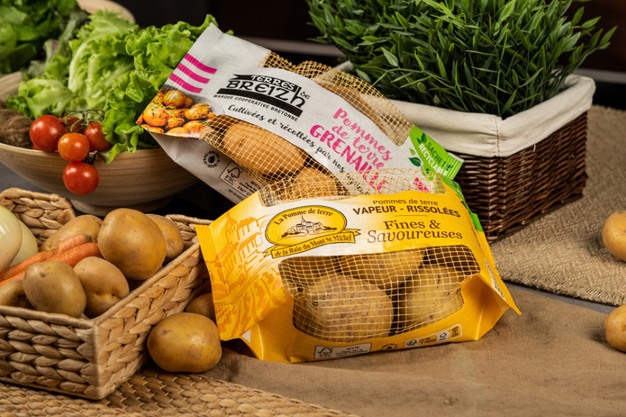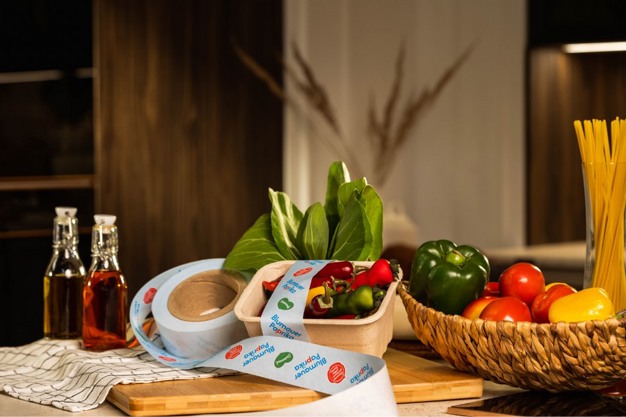Vegetables and fruits on stalls and in store displays are a field of competition and a place of struggle for the consumer's attention. How can you make sure that the customer chooses fresh products from one company over another? Marta Paprocka of Polish packaging manufacturer Silbo thinks it's a challenging time, but has solutions to the problems: "In this sector, it seems difficult, especially now, when EU and national laws limit the possibility of packaging vegetables and fruits, introducing bans and restrictions on plastic packaging. However, we still have specific tools at our disposal that influence customers' purchasing decisions."
According to Parocka, the pandemic changed the perspective on unpackaged produce, as people had safety concerns. "It's obvious that customers choose vegetables that look fresh and plump. Ten years ago, vegetables and fruits with any blemishes or non-standard shapes were eliminated from stores, which fortunately has changed, mainly thanks to the efforts of producer associations and information campaigns proclaiming that imperfect vegetables and fruits are equally valuable products. The pandemic brought another challenge to the fruit and vegetable market, because consumers began to worry about the hygiene and safety of fresh products. At that time, sales of packaged and portioned products increased significantly, and customers were reluctant to choose products offered loose."

Even now, years later, Paprocka feels that consumers value safe foods more, and packaging helps create the trust of food being safe to eat: "Although the pandemic is now behind us, the share of packaged fruit and vegetables in retail sales is constantly growing. Last year, the share of packaged fruit in retail sales in Italy was almost 38%, and their value was 45% higher. In Poland, the share of packaged vegetables is also higher and last year exceeded half of the sales value. Experts point to the relationship: in uncertain times, and the war in Ukraine also had an impact on this, consumers want safe products. Safe means: well-labelled, traceable, high-quality. But how can we assure the customer of all this? We think the carrier of this information is appropriate packaging."
Paprocka emphasizes that the new packaging rules in Europe should be approached as an opportunity to eliminate weaknesses of the old ways. "The legal regulations coming into force, banning plastic packaging, introduce new rules for packaging fruit and vegetables. However, this should not be seen as a limitation, but as an opportunity. Because changing the packaging is an opportunity to stand out on the market, to reposition the product. Now we can eliminate previous weaknesses and focus on sales on new principles. This is a time when everyone starts from the same point, adapting to new conditions. It is worth preparing for this now and taking a good position in the race for the customer. Changing packaging is a relatively long process. It requires preparing projects, selecting functional packaging materials, making decisions on grammages, testing, checking the work on packaging machines. All this, depending on the amount of work, can take from six months to even a year. It is not worth waiting for the moment when legal changes will force us to act under time pressure. The delivery of raw materials to packaging manufacturers often generates distant deadlines."

Creating new packaging isn't cheap, but Paprocka feels that making the right choices with paper packaging already increase the quality perception of the packaging and produce: "Investment in packaging should pay off. This is the assumption that should be made when preparing for the introduction of new packaging. Therefore, you should use its marketing potential as much as possible. Just replacing plastic with paper puts our product in a higher class. Paper is perceived as more noble and, of course, more ecological, and this evokes positive associations with the manufacturer. A cognitive bridge is built: the manufacturer cares about the environment, cares about quality and as a result its products are considered healthy and safe. Choosing a paper package for a portion of fruit and vegetables under 1.5 kg is literally like shaking hands with a customer. The customer wants a small portion because it is convenient and sufficient for them in a small household. It is important that the package has a window or some other type of transparent strip or opening that allows consumers to assess its contents."
What helps with gaining trust among consumers is informing them of the ecological choice they're making when they buy the product in your packaging, Paprocka explains. "In addition, choosing the color of the package that identifies the producer; with clear information, such as the origin, harvest time, suitability of the package for recycling or composting. All of these factors have a positive effect on consumer trust and makes the producer credible. Placing recipes on the back of the package or even photos of workers involved in the harvest is also an attractive practice. By doing this, we show that we are honest, have nothing to hide, work with joy and want our customers to be satisfied. Anything that makes the customer's life easier and at the same time gives him or her a feeling of being special and cared for, will bring producers success in sales."

"From a practical point of view, we can pack a maximum of 2.5 kg of product in paper packaging. Portions of vegetables and fruit above 1.5 kg. can still be packed in plastic materials under the new EU law. In this product category, the manufacturer's task is to provide packaging that is just as attractive, durable and provides so-called added value," Paprocka states. "This can be, for example, information on the reduction of plastic content, compared to the original packaging, numbers showing the consistent reduction of the use of plastics by the manufacturer; the use of printing inks that are neutral for air, water and soil, information on the carbon footprint of the packaging, care for the health and household budget of customers and an expression of concern for proper waste segregation. Consumers also appreciate comfortable handles and, above all, the design of the packaging itself."
"It is worth gradually diversifying the offer, offering products in different packaging and weights. This will allow us to secure sales in several consumer categories. - As a marketer, I advise creating, for example, a premium product category in which the customer is willing to pay a little more for a high-quality product, packaged in ecological materials. At the same time, let's also offer economic options, aimed at housewives and families. As manufacturers, we have two tasks: to distinguish our brand with packaging, design, communication, and so on, and also to distinguish the customer. We can only do this by responding to the needs of the consumer. And these are diverse, depending on their age, place of residence, household budget and social and environmental awareness. Packaging is an excellent tool for differentiating and scaling sales," Paprocka concludes.
For more information:
Marta Paprocka
Silbo
Email: [email protected]
www.silbo.pl
www.silbopackaging.com
